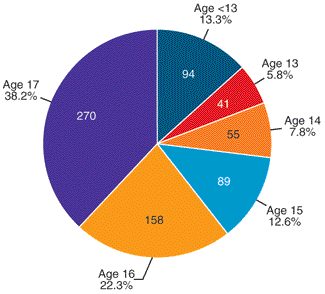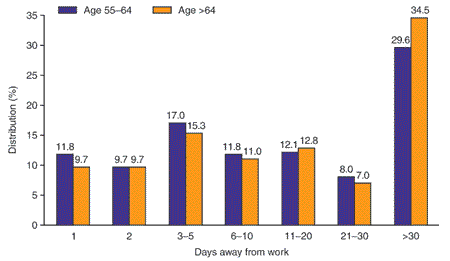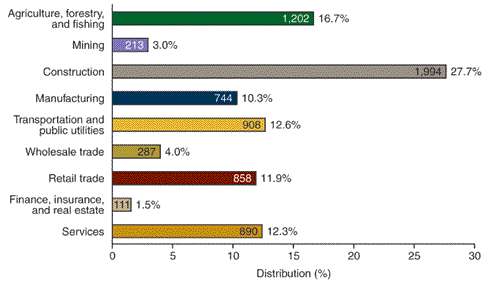OCCUPATIONAL HEALTH DISPARITIES

Inputs: Occupational Safety and Health Risks
As the workforce becomes more diverse, it has also become clear that there are disparities in the burden of disease, disability, and death experienced by certain population groups, including low-income workers and racial/ethnic minorities. The public health research community has conducted many excellent studies which document the growing disparities in rates of health outcomes such as cardiovascular disease, cancer, and mental health, as well as in the access to and quality of care. Although not as well researched, current statistics indicate that disparities also exist in the rates of occupational illnesses and injuries. Occupational hazards are known to be distributed differentially; workers with specific biologic, social, and/or economic characteristics are more likely to have increased risks of work-related diseases and injuries. Therefore, one of the priority areas established by the National Occupational Research Agenda (NORA) in 1996 was improving research to define the nature and magnitude of risks experienced by these special populations and to develop appropriate intervention and communication strategies.
Although much of the increased risk among special populations may be due to their disproportionate employment in high-hazard industries such as construction and agriculture, other social, cultural, and political factors may compound their risks. For example, minority workers may face discriminatory employment practices or hostility from supervisors or coworkers which may contribute to their risk. Some workers, particularly immigrant workers, may face literacy issues that make current training and chemical and safety labeling practices ineffective. Cultural factors may influence the way workers perceive risk factors or approach work tasks. Workers may lack health insurance and/or access to healthcare services which may compound their work-related risk factors. Older workers who, for economic or social reasons, choose to return to the job market face physiologic and cognitive challenges that have not been adequately researched.
Prior to the creation of NORA, NIOSH had ongoing initiatives focused on two important special population groups, young workers and agricultural workers, including migrant farmworkers. The Special Populations at Risk Team collaborated with these initiatives by including representatives as team members and developing collaborative activities. In addition, the team has developed research agendas and promoted increased funding for other priority populations including older workers, immigrant workers, and disabled workers. Occupational risks of five of these populations are described below.
Agricultural Workers
The broad occupational category of farmworker includes both family farmers who are self-employed, as well as approximately 2 million hired farmworkers. In the United States, as of 2002, 84% of hired farmworkers were Hispanic and 79% were born in Mexico. One-third of the foreign-born workers are recent immigrants who have worked in the United States for 2 years or less and many are living apart from their families, creating additional stress due to social isolation. Farmworkers are younger than the general workforce (average age of 31) and most are men (79%). Most have a very low literacy level which can have significant impact on their ability to read warning labels or understand safety instructions. Only 22% of workers can read and write English well and over half have less than an eighth grade education. For many who come from indigenous parts of Latin America, Spanish is their second language. Almost half (42%) of farmworkers need to migrate and live temporarily away from their homes in order to find sufficient work. Temporary housing may often be crowded and inadequate. Hired farmworkers work in agriculture about 8 months of the year on average. Due to low wages and extended periods of unemployment, more than half of farmworkers have family incomes less than $15,000 per year. A large proportion of hired farmworkers (53%) is not legally authorized to work in the United States; therefore they may be vulnerable to abuse and may be less likely to report injuries, illnesses, and mistreatment.
For a variety of reasons, standard nonfatal occupational injury and illness data do not adequately encompass information associated with agricultural production, especially among migrant and seasonal farmworkers. To fill this data gap, NIOSH has undertaken specific data collection efforts to assess the magnitude and burden of injuries associated with farm operations. These specific data can be used to prioritize, target, and develop effective prevention strategies. NIOSH, in collaboration with other federal agencies, oversees three separate data collection efforts: a farm operator injury survey and a minority farm operator injury and health survey which collect data for adult workers and children who live on, visit, or work on the farm; and a workplace-based survey of hired farmworkers where data are collected on workers and their children. Together, these surveys have identified the major health issues facing farm operators and farmworkers and have identified health outcomes where disparities exist among white non-Hispanics and minority farmworkers and farm operators. The studies point to areas where additional, focused research is needed to better develop prevention programs. For example, the most common health outcome reported by hired farmworkers is musculoskeletal disorders and therefore the development and dissemination of the publication Simple Solutions: Ergonomics for Farmworkers was a priority.
Young Workers
Approximately 2.2 million adolescents aged 16 and 17 years worked in the United States in 2003. Official employment statistics are not available for younger adolescents who are also known to work, especially in agricultural settings. Teens are at risk of injury, illness, and even death on the job, just as other workers are, but may face additional risk due to their youth.

Number and distribution of fatal occupational injuries by age among young workers, 1992-2002. Fatal occupational injuries among workers aged 16 and 17 accounted for 158 and 270 fatalities, respectively, or 60.5% of all fatal occupational injuries among workers aged 17 and younger for the period 1992-2002. A significant number of deaths (94 or 13.3% of the total) occurred among youths less than 13 years of age (Source: BLS [2003d]. in NIOSH Worker Health Chartbook, 2004, Fig 5-6 ).
In 1999, an estimated 84,000 work-related injuries and illnesses were treated in hospital emergency departments among youth less than 18 years of age (5.2 injuries per 100 working youth). Like all new workers, young workers are at increased risk for injury. Since the level of physical and cognitive development in teens is variable, developmental characteristics may also place youth at risk. Shorter teens may have a harder time reaching machines and may not have the physical strength required for certain tasks. Even when youth have reached adult stature, their psychological and cognitive maturity may lag. Employers may assign them tasks to which they are not yet cognitively prepared. Their extreme enthusiasm and a desire to do well, although very positive attributes, may make them uncomfortable asking questions or expressing concerns about their ability to perform a challenging task.
In addition to the specific hazards youth may face at work, unintended consequences may also affect their ability to function and succeed in their school and social life. Using a relatively arbitrary cutoff, policymakers and researchers divide youth labor into high-intensity labor (more than 20 hours per week) and low-intensity labor. While low-intensity labor is positively associated with future post secondary education, high-intensity labor has been found to be associated with substance abuse, inadequate sleep, and decreased eventual educational attainment.
Older Workers
The U.S. labor force is not only growing but it is becoming older. The Bureau of Labor Statistics projects an increase of 7.3 million workers aged 55 to 64 between 2000 and 2010. Not only do biological and physical functioning decline with age but cognitive functioning may, also. Cognitive functioning has become increasingly important in many workplaces. Given the changes that accompany aging, older workers might be at elevated risk for occupational injuries and illnesses. However, research conducted in workplace settings suggests a more complex relationship between aging and worker health.4 For some outcomes, older workers are indeed at a disadvantage. For example, older workers have been found to take longer to return to work following an injury, illness, or disability,5 reflecting a decline in recuperative ability of the body that occurs with age. Older workers also show increased susceptibility to certain types of workplace practices; shift workers over age 40 report more sleep disruption than younger workers following an overnight shift. For other outcomes, the relationship with age is either mixed or nonexistent. For example, older workers tend to experience fewer nonfatal injuries than younger workers.6, 7 However, when an older worker is injured, it is more likely to be severe or fatal than when a younger worker is injured.8, 9, 10

Distribution of nonfatal occupational injuries and illnesses involving days away from work among workers aged 55 and older in private industry by days away from work, 2001. Workers aged 65 and older tended to experience lower percentages of short-term work loss (1 and 3–5 days) and a substantially higher percentage of long-term work losses of 31 days or more (29.6% for workers aged 55–64, and 34.5% for those aged 65 and older). Workers aged 55–64 had a median loss of 10 days away from work, and those aged 65 and older had a median of 14 days. Overall, private sector workers had a median of 6 days away from work (Source: BLS [2003b,c]. in NIOSH Worker Health Chartbook, 2004, Fig 5-29 ).
Hispanic and Foreign-Born Workers
As the U.S. labor force grows, the number and proportion of Hispanic workers is increasing. However, limited data are available on occupational injury and disease risks among Hispanic workers. During 1992–2002, BLS reported that the number of fatal injuries ranged from 533 to 895 per year among Hispanic workers. Cases of nonfatal occupational injury and illness among Hispanic workers show a fairly consistent upward trend, from 8.5% in 1992 to 12.5% in 2001.
Completed Fatality Assessment and Control Evaluation Program (FACE) investigations of fatally injured Hispanic workers are listed with links to full reports at:
http://www2a.cdc.gov/NIOSH-FACE/state.asp?state=ALL&Incident_Year=ALL&Category2=0009
.

Distribution and number of fatal occupational injuries among Hispanic workers by industry, 1992–2002. During this period, the largest proportion of fatal occupational injuries among Hispanic workers was in construction, which accounted for 27.7% of the total, or 1,994 cases (Source: BLS [2003d]. in NIOSH Worker Health Chartbook, 2004. Fig 5-37 ).
Workers with Developmental Disabilities
Approximately 1.6% of school-age children and 1.5% of adults in the United States have developmental disabilities.11 A developmental disability is a condition of someone who, from an early age, has had one or more mental or physical impairments that will likely continue indefinitely. Examples include cognitive impairments (e.g., mental retardation is the most common developmental disability), sensory impairments (e.g., blindness and deafness), neurological disorders (e.g., autism, epilepsy, and cerebral palsy), and genetic disorders (e.g., Down syndrome and fragile-X syndrome).
An estimated 70% of working-age adults with developmental disabilities are unemployed. However, the number of those employed increased from approximately 280,000 in 1990 to nearly 400,000 in 1996.7 This growth trend will likely continue given that the federal government has targeted the employment of persons with disabilities as a national priority. Recent legislation, such as the 1997 amendments to the Individuals with Disabilities Education Act, the Workforce Investment Act of 1998, and the Ticket to Work and Work Incentives Improvement Act of 1999, as well as other federal efforts, including President Bush’s New Freedom Initiative of 2001, indicate that promoting the employment of people with disabilities has become an even greater area of focus.
Of the workers employed in 1996, 305,000 (77%) were in facility-based settings and 91,000 (23%) were in integrated employment.7 Facility-based settings include day-habilitation programs and sheltered workshops (nonprofit businesses predominantly employing people with developmental disabilities and other chronic mental and physical impairments). Integrated employment includes competitive and supported employment.
Based on a 1999 pilot study of 11 sheltered workshops in four states, NIOSH published recommendations for protecting the health and safety of workers with developmental disabilities. An important conclusion of the study was that sheltered workshop employees would benefit from increased management awareness and a more proactive approach to worker health and safety. In some cases, workshop managers were found to have limited understanding of federal and state regulations concerning the health and safety of their employees. Although the sample size was limited, NIOSH researchers also observed differences not only in the approaches that states use to administer programs affecting workers with developmental disabilities but also in the level of oversight given. No compilation exists of federal and state agencies having regulations affecting workers with developmental disabilities.
Although much was learned through the NIOSH study of sheltered workshops, significant gaps still exist in our understanding about the occupational safety and health experiences of workers with developmental disabilities. These gaps include information about the types of industries and jobs in which these workers are employed, the health and safety hazards they face, and the relevant organizations and state and federal agencies that could be potential partners in the effort to promote safe and healthful work experiences for this population of workers. There appears to be particularly scant information about the extent of occupational injuries and illnesses among workers with developmental disabilities as well as the individual and workplace factors that may place these workers at increased risk of injury and illness. It is hypothesized that this population is particularly vulnerable in the workplace, given their cognitive and communication challenges. NIOSH’s earlier study supports this concern. However, there may also be examples of accommodations, effective training programs, communication tools, and other support systems currently in place in some workplaces that help prevent occupational injuries and illnesses among these workers. Collecting examples of “best practices,” with the goal of promoting recommended prevention strategies, is one of the goals of the proposed project.
References
- Wegman DH. Older workers. Occup Med. 1999 Jul-Sep;14(3):537–57.
- Crook J and Moldofsky H. The probability of recovery and return to work from work disability as a function of time. Qual Life Res. 1994 Dec;3 Suppl 1:S97–109.
- Leigh, J.P. Individual and job characteristics as predictors of industrial accidents. Accident Analysis and Prevention, 1986;18(3), 209-216.
- Lenhart SW. (2000) Protecting Workers with Developmental Disabilities. Applied Occupational and Environmental Hygiene. 15(2):171-181.
- Kisner SM and Pratt SG. Occupational fatalities among older workers in the United States: 1980-1991. J Occup Environ Med. 1997 Aug;39(8):715–21.
- Bailer, AJ, Bena, JF, Stayner, LT, Halperin, WE and Park, RM 2003 External cause specific summaries of occupational fatal injuries - Part I: an analysis of rates. American Journal of Industrial Medicine 43:237–250.
- Bailer, AJ, Bena, JF, Stayner, LT, Halperin, WE and Park, RM 2003 External cause specific summaries of occupational fatal injuries - Part II: an analysis of years of potential life lost. American Journal of Industrial Medicine 43:251–261.
- Dell Orto AE, Marinelli RP, eds. [1995]. Encyclopedia of disability and rehabilitation. New York, NY: Simon and Schuster Macmillan.
Economic Factors Next Page: National Research Agenda (NORA)
- Page last reviewed: December 19, 2012
- Page last updated: December 19, 2012
- Content source:


 ShareCompartir
ShareCompartir